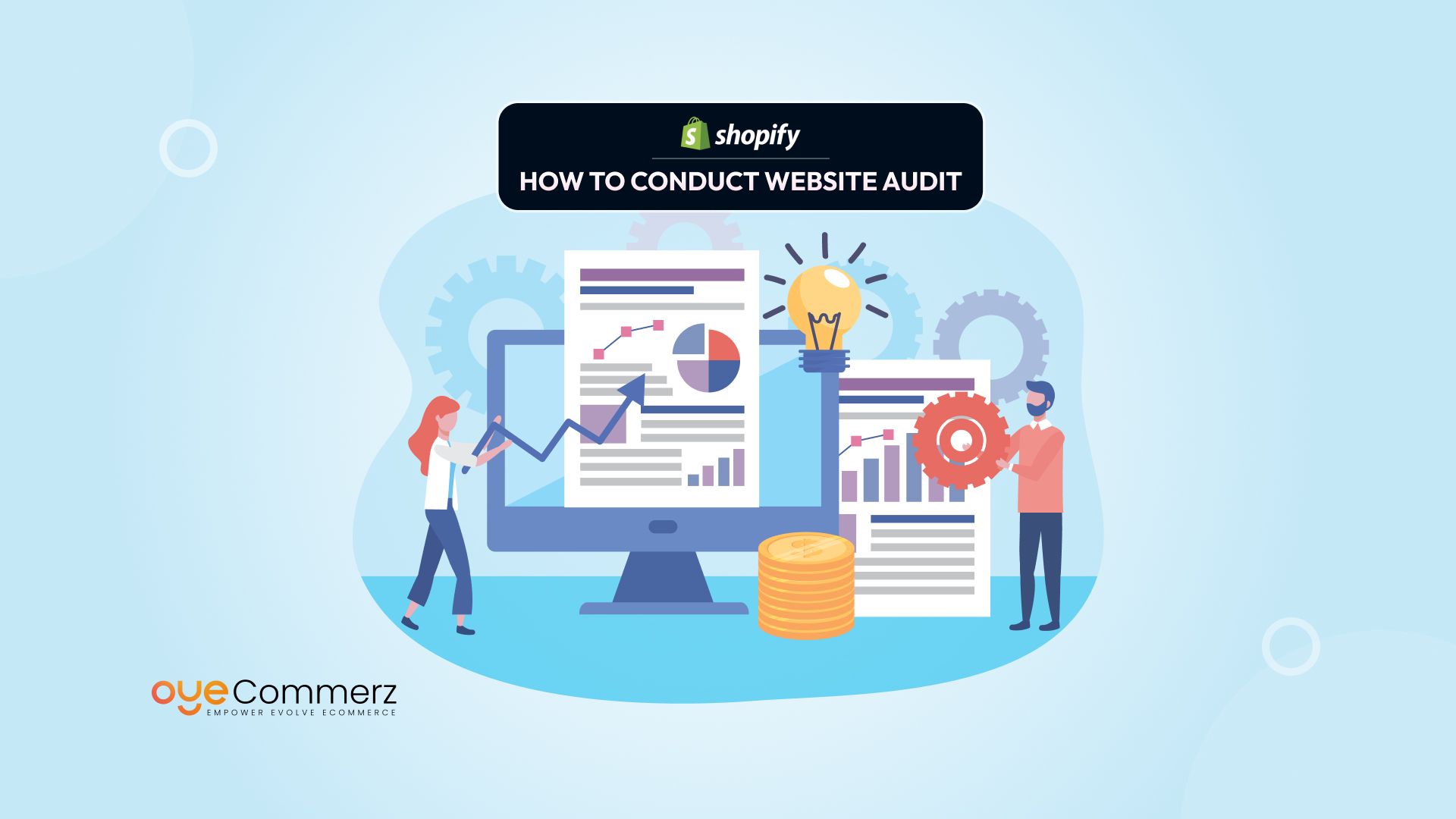In today’s competitive market, 79% of US shoppers say they’ll abandon a brand after just one bad online experience.
If your Shopify store isn’t performing at its best, you could be losing customers — and revenue — without even realizing it.
A Shopify Website Audit is the fastest way to uncover hidden issues that hurt your traffic, sales, and customer loyalty.
The problem? Most store owners focus only on the visible parts (like design) and ignore deeper technical flaws that silently kill conversions.
And here’s the tough part — even small mistakes like a slow checkout page, poor SEO setup, or weak mobile experience can crush your growth.
That’s why a complete, strategic Shopify Website Audit isn’t optional anymore — it’s essential for maximum results.
In this guide, we’ll show you exactly how to audit your Shopify store from top to bottom — whether you’re a new entrepreneur or scaling fast.
Table of Contents
ToggleWhy SEO Matters More Than Ever in 2025
A Shopify Website Audit is a full review of your online store’s performance, design, content, and technical setup — all aimed at identifying what’s working, what’s broken, and where major improvements are needed.
Think of it like a health check-up for your business.
Just as a doctor looks beyond the surface to spot hidden health risks, a Shopify Website Audit digs deep into areas like speed, SEO, user experience, mobile optimization, and security.
When done right, an audit highlights silent issues that can cost you sales, damage your brand reputation, and lower your search engine rankings.
More importantly, it shows you exactly what actions to take to maximize your store’s performance, drive more traffic, and boost conversions.
Whether you’re launching your first store or scaling up to meet growing demand, regular audits ensure your Shopify site stays sharp, competitive, and ready to deliver results in today’s fast-moving e-commerce landscape
Why Your Shopify Store Might Be Underperforming (And You Don’t Even Know It)
Running a beautiful online store doesn’t guarantee success — especially if unseen issues are dragging your performance down.
Without a regular Shopify Website Audit, you might be losing traffic, frustrating customers, and missing out on sales without even realizing it.
Here’s the reality:
Shoppers today expect fast, smooth, and secure experiences. If your store falls short, they’ll bounce — often straight to your competitor.
Common hidden problems a Shopify Website Audit reveals include:
- Poor Mobile Optimization
Over 70% of US online shoppers buy via smartphones. If your store isn’t mobile-friendly, you’re instantly losing customers. - Slow Loading Speeds
A 1-second delay in page load time can reduce conversions by 7%. Slow sites kill both sales and SEO rankings. - SEO Errors
Broken links, missing meta tags, and poor URL structures prevent your store from showing up on Google when buyers are searching. - Confusing Navigation
If customers can’t find what they need in just a few clicks, they’ll leave without buying. - Security Vulnerabilities
An unsecured store not only risks data breaches but also scares away shoppers who demand trust and protection.
Without conducting a thorough Shopify Website Audit, these problems can compound over time — quietly killing your growth potential.
👉 The good news?
Identifying and fixing these issues can dramatically improve your store’s traffic, trust, and conversions — sometimes almost overnight.
Key Areas to Cover in Your Shopify Website Audit
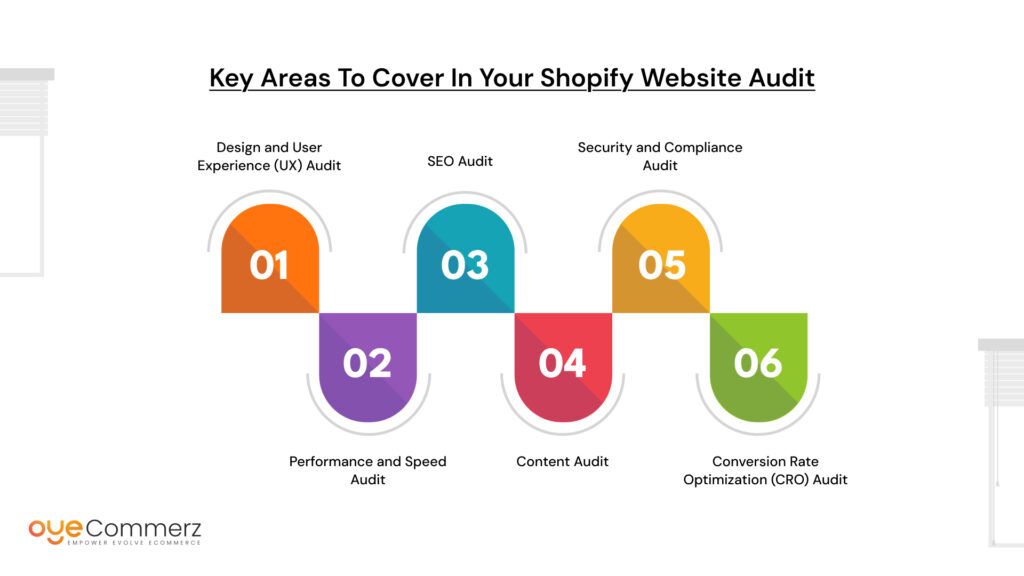
A successful Shopify Website Audit doesn’t just scratch the surface — it digs deep into every part of your store that affects user experience, search visibility, security, and conversion rates.
Here’s a complete breakdown of the essential areas you must review:
1. Design and User Experience (UX) Audit
- Mobile Responsiveness
Over half of all e-commerce traffic comes from mobile. Your Shopify store must look flawless and load fast across all devices. - Navigation Structure
Is your menu simple and intuitive? Can customers easily find products, collections, and checkout without confusion? - Brand Consistency
Colors, fonts, images, and tone should be consistent across your site to build trust and brand recognition.
2. Performance and Speed Audit
- Page Load Times
Aim for a load time under 3 seconds. Use tools like Google PageSpeed Insights to test and improve. - Image Optimization
Compress images without losing quality to reduce file sizes and speed up loading. - Minimizing Scripts and Apps
Too many Shopify apps or custom scripts can slow your store down — audit and remove unnecessary ones.
3. SEO Audit
- Title Tags and Meta Descriptions
Every page and product should have optimized, keyword-rich titles and descriptions. - Broken Links and Redirects
Broken pages hurt both user experience and SEO. Identify and fix 404 errors and set up proper 301 redirects. - URL Structure
Keep URLs short, clean, and descriptive for better SEO performance.
4. Content Audit
- Product Descriptions
Are they clear, persuasive, and keyword-optimized? Duplicate or thin content can hurt SEO. - Blog Health
Fresh, helpful blogs drive organic traffic. Audit your blog content for relevance, readability, and SEO strength. - Content Gaps
Identify missing topics that your audience is searching for — and create content to fill those gaps.
5. Security and Compliance Audit
- SSL Certification
A secure HTTPS connection is non-negotiable for trust and SEO. - Data Protection Compliance (GDPR/CCPA)
Make sure your store complies with US and international data privacy laws to avoid legal risks. - App and Plugin Security
Regularly audit installed apps and plugins to ensure they are safe, updated, and necessary.
6. Conversion Rate Optimization (CRO) Audit
- Checkout Flow
The fewer clicks to purchase, the better. Test your checkout process for speed, simplicity, and clarity. - Call-To-Actions (CTAs)
Are your “Buy Now”, “Add to Cart”, and “Sign Up” buttons clear and persuasive? - Trust Signals
Display customer reviews, security badges, easy return policies, and social proof prominently.
Pro Tip:
Start with a basic Shopify Website Audit every quarter — and a full deep-dive audit at least once a year for maximum impact.
Essential Tools You’ll Need for a Shopify Website Audit
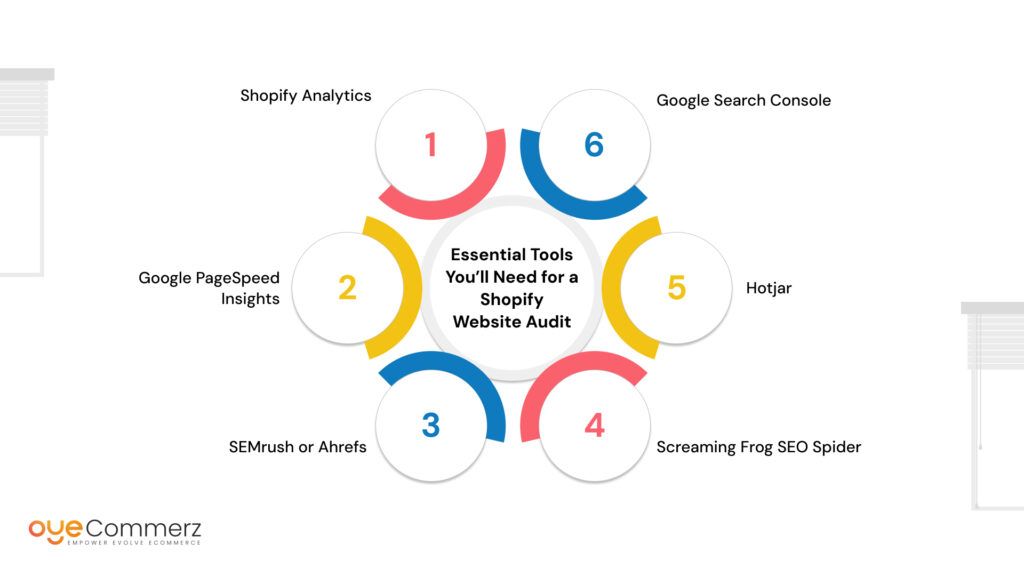
A great Shopify Website Audit isn’t just about knowing what to look for — it’s about using the right tools to uncover hidden problems and opportunities fast.
Here are some of the must-have tools to make your audit thorough and effective:
1. Shopify Analytics
Your store’s built-in analytics offer powerful insights into visitor behavior, conversion rates, top-performing products, and more.
✅ Track bounce rates, checkout abandonment, and sales funnel performance.
2. Google PageSpeed Insights
Site speed is crucial. Use this free tool to measure your Shopify store’s load time on desktop and mobile — and get actionable recommendations to speed things up.
✅ Aim for a score above 85 for both mobile and desktop views.
3. SEMrush or Ahrefs
Both tools offer deep SEO audits — analyzing broken links, keyword rankings, backlink profiles, and technical SEO issues.
✅ Quickly identify SEO errors that may be dragging your organic traffic down.
4. Screaming Frog SEO Spider
This powerful crawler scans your entire website for technical SEO problems like missing meta tags, duplicate content, redirect chains, and more.
✅ Essential for spotting issues that are often invisible to the human eye.
5. Hotjar
Want to actually see how users behave on your store?
Hotjar provides heatmaps, session recordings, and visitor feedback tools to pinpoint UX and conversion obstacles.
✅ Discover exactly where users drop off — and fix it.
6. Google Search Console
Monitor how Google views your store.
Identify crawl errors, mobile usability issues, and keyword opportunities straight from Google’s perspective.
✅ Free and absolutely critical for long-term SEO success.
Pro Tip:
Using a combination of these tools gives you a 360° view of your Shopify Website Audit — ensuring you don’t miss anything critical.
DIY Audit vs Professional Audit: Which One Is Right For You?
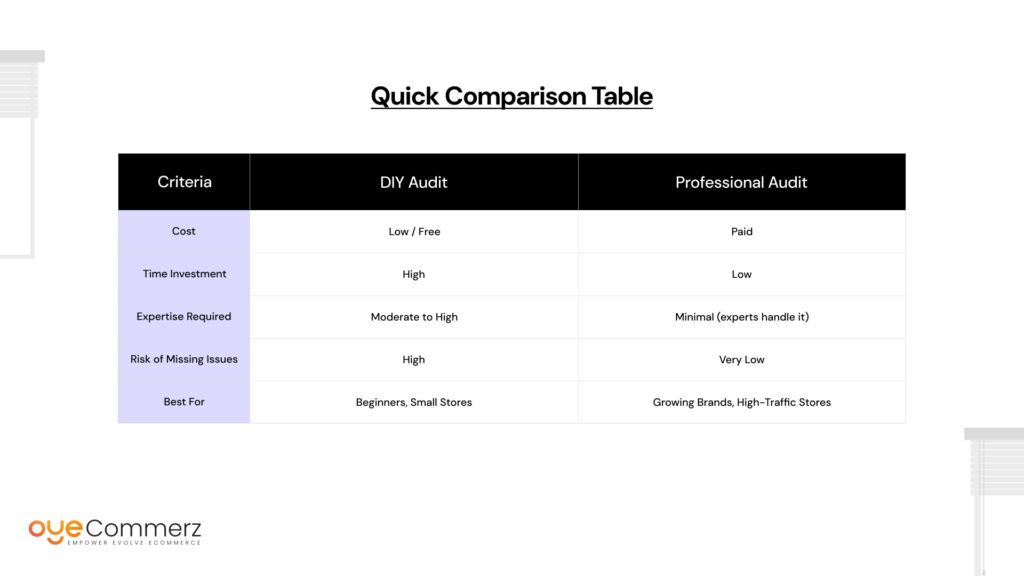
When it comes to a Shopify Website Audit, one of the biggest decisions you’ll face is whether to handle it yourself or bring in professional help.
Both options have their pros and cons — and the right choice depends on your goals, skills, and available time.
Here’s a closer look:
DIY Shopify Website Audit
Pros:
- Low or no cost if you use free tools
- Immediate action if you spot quick fixes
- Full control over the audit process
Cons:
- Steeper learning curve for beginners
- Risk of missing hidden technical or SEO issues
- Time-consuming, especially for larger stores
DIY audits can be a good option if you have a small, simple Shopify store and are comfortable using tools like Google PageSpeed Insights and Shopify Analytics. However, without deep technical knowledge, it’s easy to overlook critical problems that affect performance and sales.
Professional Shopify Website Audit
Pros:
- Comprehensive analysis across design, SEO, speed, security, and conversions
- Access to advanced audit tools and expert insights
- Customized recommendations based on your specific store setup and goals
Cons:
- Involves a service fee
- Requires clear communication to align on goals and priorities
Professional audits are best suited for established businesses, high-traffic stores, or anyone planning a major growth push. They offer in-depth strategies that go far beyond surface-level checks, helping you unlock faster growth and stronger ROI.
Bottom Line:
If you are serious about scaling your Shopify store and want to ensure no issues are holding you back, a professional Shopify Website Audit delivers faster, deeper, and more reliable results than going solo.
New to E-Commerce? Here’s How to Start Smart with Your Shopify Website Audit
Starting a new online store can feel overwhelming, especially when it comes to technical tasks like a Shopify Website Audit.
The good news is, you do not need to be an expert to get the basics right — and even a simple audit can create a strong foundation for growth.
If you are new to e-commerce, here is how to approach your first Shopify Website Audit without getting lost in technical complexity:
Focus on the Fundamentals First
When starting out, prioritize these critical areas:
- Mobile Optimization
Test your store on multiple devices to ensure it looks good and functions properly. - Site Speed
Use tools like Google PageSpeed Insights to check your loading times. Fast-loading pages keep customers engaged and boost conversions. - Clear Navigation
Make sure your menus, categories, and search functions are easy to use. Customers should find products within three clicks. - Basic SEO Setup
Check that every page has a unique title, a clear meta description, and descriptive URLs. - Trust Elements
Add SSL certification, clear return policies, and customer reviews to build trust with first-time visitors.
Keep It Simple
A full technical audit can be complex. If you are just starting, it is better to focus on fixing obvious issues before moving into deeper SEO or performance analysis.
Prioritize:
- Fixing broken links
- Compressing large images
- Simplifying your checkout process
- Writing clear and helpful product descriptions
Beginner-Friendly Audit Checklist
- Is your store mobile-friendly?
- Does your homepage load in under 3 seconds?
- Are your product categories easy to browse?
- Do you have clear CTAs (Add to Cart, Buy Now)?
- Are basic SEO elements like page titles and meta descriptions filled out?
Starting with these simple steps ensures your Shopify Website Audit lays a strong, scalable foundation as you grow.
Contact to Migrate your Site to Shopify Now
Common Mistakes to Avoid During a Shopify Website Audit
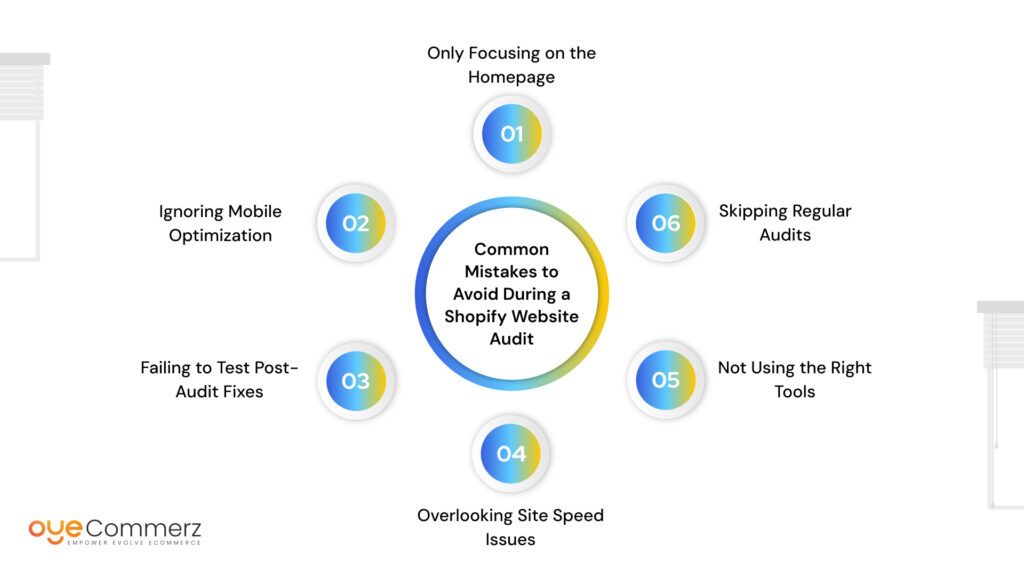
A Shopify Website Audit is a powerful tool for improving your store’s performance, but only if it’s done right. Many store owners, especially those new to e-commerce, make mistakes that can lead to missed opportunities or even worsen their store’s performance.
Here are some common mistakes to avoid during your audit:
1. Only Focusing on the Homepage
While the homepage is important, it’s not the only part of your store that matters.
Your Shopify Website Audit should examine the entire site — including product pages, checkout, and even the backend setup. Pay close attention to areas like mobile responsiveness and conversion points throughout the user journey.
2. Ignoring Mobile Optimization
With over half of all online shopping now happening on mobile devices, a mobile-optimized store is non-negotiable.
If you skip testing your site’s mobile experience during the audit, you risk alienating a large portion of your audience. Ensure that every element on your site — from images to navigation — is mobile-friendly.
3. Failing to Test Post-Audit Fixes
Fixing an issue doesn’t guarantee it’s fixed across your store.
After making changes based on your Shopify Website Audit, always re-test. This includes checking page speed improvements, testing the checkout process, and validating that SEO updates are being indexed by search engines.
4. Overlooking Site Speed Issues
A slow site can kill your conversion rate. If your audit reveals speed problems, don’t just fix a few images and move on.
Consider the impact of apps, scripts, and external integrations that might be slowing down your store. Comprehensive speed tests are essential, and don’t just focus on the homepage — every page matters.
5. Not Using the Right Tools
Trying to audit your site without using the proper tools can lead to incomplete or inaccurate results.
Make sure to use reliable tools for SEO, site speed, and technical audits — such as Google PageSpeed Insights, SEMrush, and Screaming Frog SEO Spider. These tools give you the data you need to uncover hidden issues.
6. Skipping Regular Audits
A Shopify Website Audit is not a one-time fix. E-commerce is dynamic, and issues can arise over time as you add new products, install apps, or make design changes.
Schedule regular audits (quarterly or bi-annually) to ensure your store stays optimized and competitive.
By avoiding these common mistakes, you can ensure that your Shopify Website Audit delivers real, measurable improvements to your store’s performance.
How Oyecommerz Can Help with Your Shopify Website Audit
A Shopify Website Audit can unlock the full potential of your online store, but for many store owners, the process can be overwhelming, especially if you’re unfamiliar with the technical aspects of e-commerce optimization. This is where Oyecommerz comes in.
At Oyecommerz, we specialize in helping businesses like yours get the most out of their Shopify stores by offering expert audits tailored to your unique needs. Whether you’re looking to improve site speed, enhance SEO, or ensure a smooth user experience, our team can help identify key areas for improvement and provide actionable strategies.
Why Choose Oyecommerz for Your Shopify Website Audit?
- Expertise: Our team has deep knowledge of Shopify and e-commerce best practices, ensuring that every aspect of your audit is covered, from SEO and design to backend performance and security.
- Comprehensive Audits: We go beyond surface-level checks and dig into every corner of your store to uncover hidden issues that might be affecting performance, conversions, and user experience.
- Tailored Recommendations: Based on our findings, we provide you with customized recommendations that align with your business goals, whether it’s improving your mobile experience, speeding up your checkout, or boosting your SEO.
- Ongoing Support: A Shopify Website Audit is just the beginning. We offer ongoing support to help you implement changes and monitor your store’s performance over time, ensuring sustained growth.
Ready to Optimize Your Shopify Store?
If you’re ready to take your Shopify store to the next level, Oyecommerz can help with a thorough Shopify Website Audit. Our experienced team will conduct a deep-dive analysis, pinpointing key areas for improvement and providing you with clear, actionable insights to boost your store’s performance.
Contact us today to schedule your Shopify Website Audit and start optimizing your store for maximum results.
Conclusion
A Shopify Website Audit is an essential step for any store owner who wants to stay competitive in the fast-paced world of e-commerce. Whether you’re just starting or looking to optimize an existing store, a thorough audit can identify areas for improvement and help you make data-driven decisions that enhance performance, boost conversions, and improve customer satisfaction.
By regularly conducting a Shopify Website Audit, you ensure that your store is not only functioning optimally but also evolving to meet the needs of your customers and the demands of the market.
Remember, the audit process isn’t just about finding problems — it’s about uncovering opportunities for growth. Whether you choose to perform a DIY audit or seek professional help, the key is to act on the insights you gain and continually optimize your store to achieve your business goals.
If you’re ready to take your Shopify store to the next level, consider partnering with Oyecommerz for a comprehensive, expert-led Shopify Website Audit that delivers real results. Let us help you optimize your store for maximum growth and success.
Frequently Asked Questions
A Shopify Website Audit is a comprehensive review of your online store’s performance, design, SEO, user experience, and technical setup. It’s important because it helps identify problems that could be negatively affecting your store’s speed, conversion rates, and visibility on search engines. Regular audits ensure your Shopify store is optimized for success, enhancing user experience and boosting sales.
Ideally, you should conduct a Shopify Website Audit at least once every three to six months. This helps ensure that your store remains up-to-date with the latest e-commerce trends and technology. However, if you’re launching new products, changing your store’s design, or adding apps, it’s a good idea to perform an audit more frequently to maintain optimal performance.
Yes, a Shopify Website Audit can significantly improve your SEO rankings. The audit identifies SEO issues like broken links, missing meta descriptions, poor site structure, and slow loading times — all of which can harm your search engine visibility. By fixing these problems, you can improve your store’s organic search rankings, leading to more traffic and potential sales.
A Shopify Website Audit evaluates how visitors interact with your store. It identifies pain points such as slow page loading times, confusing navigation, or unresponsive design, which can negatively impact user experience. By addressing these issues, you can create a smoother, more enjoyable shopping experience that encourages customers to stay longer and make purchases.
To conduct an effective Shopify Website Audit, you’ll need tools such as Google PageSpeed Insights, SEMrush, Screaming Frog SEO Spider, and Google Analytics. These tools help analyze site speed, identify SEO errors, and track user behavior. Using the right tools ensures that you catch both visible and hidden issues affecting your store’s performance.

